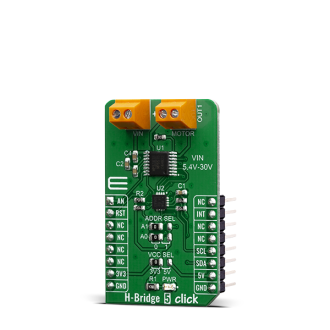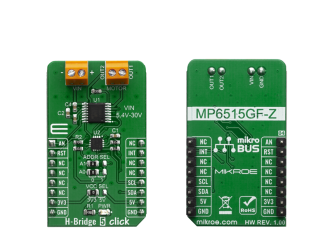
We strongly encourage users to use Package manager for sharing their code on Libstock website, because it boosts your efficiency and leaves the end user with no room for error. [more info]

Rating:
Author: MIKROE
Last Updated: 2019-11-22
Package Version: 1.0.0.0
mikroSDK Library: 1.0.0.0
Category: Brushed
Downloaded: 4491 times
Not followed.
License: MIT license
The H-Bridge 5 Click is designed for control DC motors and inductiv loads. This Click board contains the MP6515GF-Z, a H-bridge motor driver from MPS, It features an Full H-Bridge driver with Internal safety features include over-current protection, input over-voltage protection, under voltage lockout (UVLO), and thermal shutdown.
Do you want to subscribe in order to receive notifications regarding "H-Bridge 5" changes.
Do you want to unsubscribe in order to stop receiving notifications regarding "H-Bridge 5" changes.
Do you want to report abuse regarding "H-Bridge 5".


Library Description
The library covers all the necessary functions that enables the usage of the H-Bridge 5 Click board. It initializes and defines the I2c driver and drivers that allow full control of the device to the user. User can use the device to control foreward and reverse motion, apply diferent kinds of brake functions and synchronization fast decay functions, enable and disable device, or to put it to sleep. For better control over the device generic read and write functions are made available to the user as well as "set port" and ADC functions.
Key functions:
void hbridge5_foreward() - Function is used to put motor into foreward motion.void hbridge5_reverse() - Function is used to put motor into reverse motion.void hbridge5_brake_low() - Function is used to brake motor to a halt.Examples description
The application is composed of three sections :
void application_task ( )
{
hbridge5_foreward( );
Delay_ms( 3000 );
hbridge5_brake_low( );
Delay_ms( 1000 );
hbridge5_reverse( );
Delay_ms( 3000 );
hbridge5_brake_low( );
Delay_ms( 1000 );
}
Other mikroE Libraries used in the example:
Additional notes and informations
Depending on the development board you are using, you may need USB UART click, USB UART 2 click or RS232 click to connect to your PC, for development systems with no UART to USB interface available on the board. The terminal available in all MikroElektronika compilers, or any other terminal application of your choice, can be used to read the message.